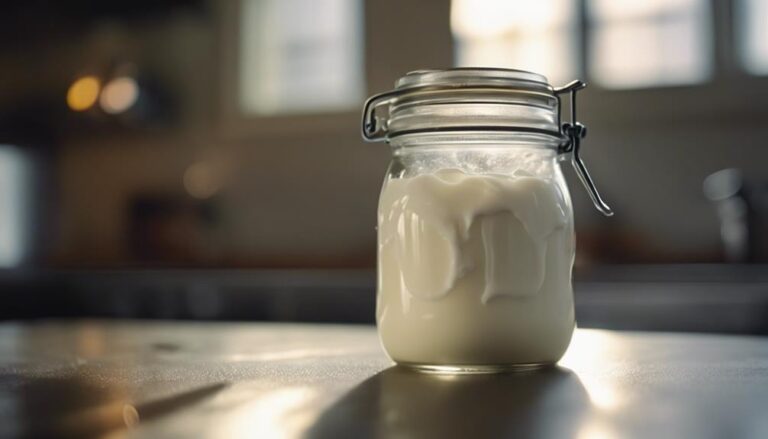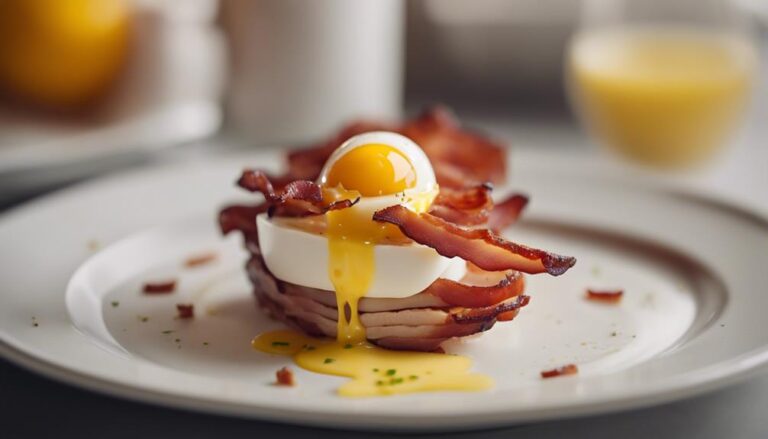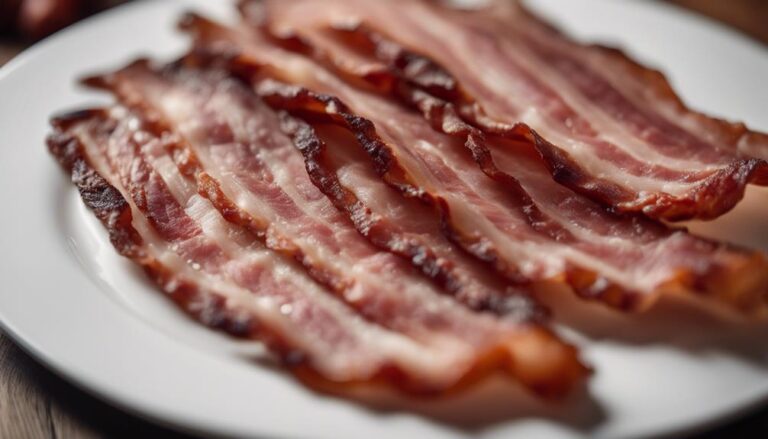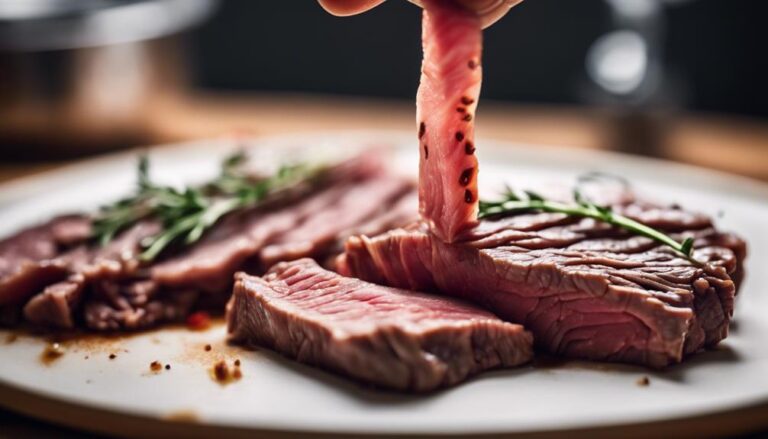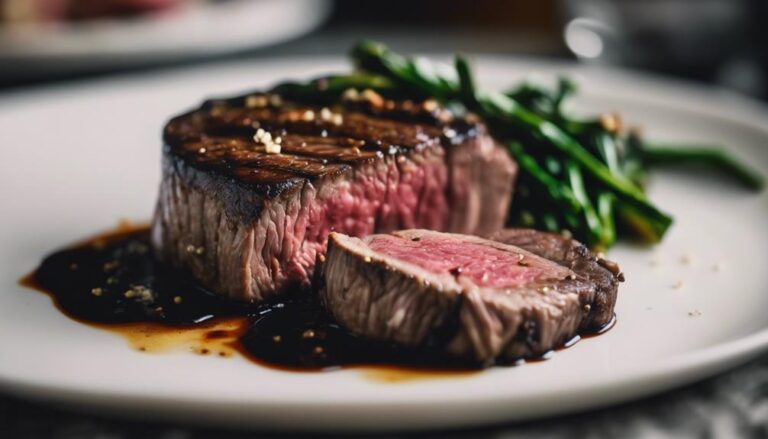Sous Vide Whole Chicken: Juicy Every Time
Cook your sous vide whole chicken to perfection every time by sealing in the flavors and juices. Infuse your bird with your favorite seasonings before vacuum-sealing for best taste. Guarantee safety by cooking at 150°F for 6 hours, ensuring a pasteurized meal. Finish in the oven for a crispy skin that will have you coming back for more. Elevate your culinary journey with sous vide cooking and enjoy the tender, flavorful results. Master this technique and let your taste buds thank you. The secret to perfect sous vide chicken awaits your discovery.
What You Will Learn Here
- Sous vide whole chicken ensures consistent juiciness every time.
- Precise temperature control guarantees perfect tenderness.
- Infuse flavors during sous vide for enhanced taste.
- Cook at 150°F for 6 hours for juicy and safe results.
- Finish in oven for crispy skin texture.
Sous Vide Origins
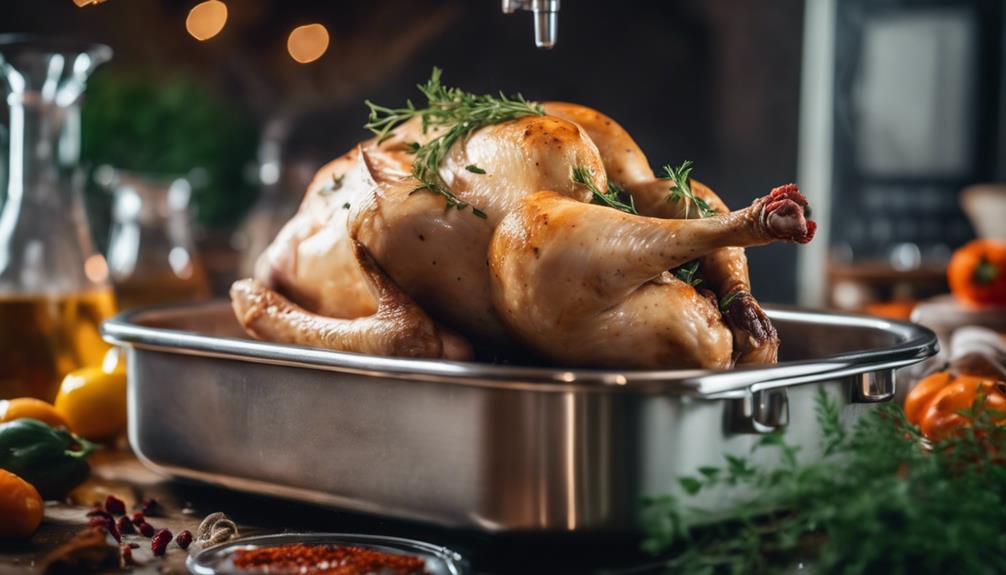
Let's take a trip back to the culinary roots of sous vide cooking. Originating in France in the 1970s, this method revolutionized how chefs achieved precision and consistency in their dishes.
As you explore the history, evolution, and impact of sous vide, you'll uncover a world where flavor and moisture are meticulously preserved, elevating the dining experience to new heights.
Sous Vide History
Originating in France in the 1970s, sous vide cooking revolutionized the culinary world with its precise technique and exceptional results. Georges Pralus, a French chef, played a pivotal role in popularizing sous vide by utilizing it to cook delicate foie gras to perfection. This cooking method entails sealing food in a bag and immersing it in a water bath maintained at precise temperatures for extended periods. Initially embraced in professional kitchens for its ability to consistently deliver tender and flavorful dishes, sous vide has now transitioned into the realm of home cooks with the introduction of user-friendly sous vide machines. The evolution of sous vide has empowered individuals to effortlessly create restaurant-quality meals in the comfort of their own kitchen.
| Sous Vide History | |
|---|---|
| Origins | France, 1970s |
| Main Innovator | Georges Pralus |
| Key Aspects | Cooking technique, water bath, precise temperatures, extended periods, professional kitchens, home cooks, sous vide machines, foie gras |
Cooking Method Evolution
The evolution of sous vide cooking from its origins in the 1970s has paved the way for a culinary revolution in the way food is prepared and enjoyed.
This cooking method, involving vacuum-sealing food like chicken in a bag and cooking it in a water bath at precise temperatures, has undergone significant evolution. What started as a technique used by professional chefs to maintain food quality has now become accessible to home cooks worldwide.
The evolution of sous vide has made it easier for everyone to achieve restaurant-quality results in their own kitchens. This precision cooking method has transformed the culinary landscape, offering both amateurs and experts alike the opportunity to create succulent and flavorful dishes like whole chicken with ease.
Modern Culinary Impact
With its roots in the precision cooking of foie gras in 1960s France, sous vide has profoundly impacted modern culinary practices by elevating the quality and consistency of dishes through its innovative technique. Sous vide involves vacuum-sealing food to preserve its flavors and textures, then cooking it in a water bath at a precise, constant temperature.
Chefs like Georges Pralus and Bruno Goussault further developed this method, leading to a culinary revolution. By providing precise control over cooking temperatures, sous vide guarantees high-quality results consistently. This technique not only enhances taste but also revolutionizes food preservation, making it a game-changer in the culinary world.
Chicken Seasoning Varieties
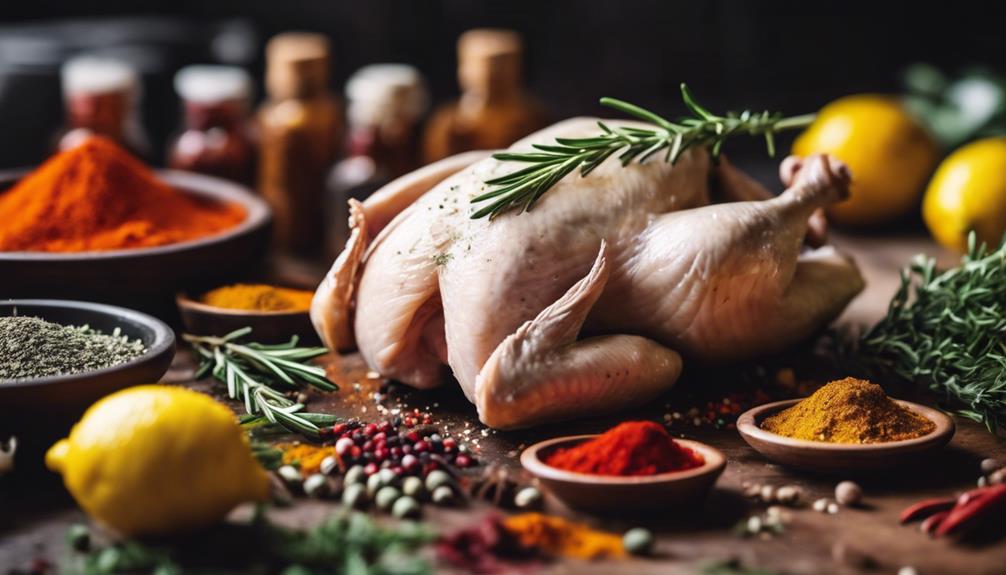
Enhance the flavor of your sous vide chicken by exploring a variety of seasoning options ranging from zesty lemon to savory taco blends. When it comes to seasoning your chicken breast for sous vide cooking, the possibilities are endless. Here are some fantastic options to elevate the taste of your dish:
- Dry Rubs:
- Lemon zest: Bright and citrusy notes that pair perfectly with chicken.
- Taco seasoning: A flavorful blend of spices for a zesty kick.
- Italian seasoning: A classic mix of herbs like oregano, basil, and thyme for a Mediterranean twist.
- Wet Sauces:
- BBQ sauce: Sweet and tangy flavors that caramelize beautifully on the chicken.
- Creamy mushroom sauce: Rich and indulgent, adding depth to the dish.
- Pesto: A fresh and herby sauce that complements the chicken's natural taste.
- Herbs and More:
- Salt, pepper, and herbs: Simple yet effective for a classic flavor profile.
- Lemon slices: Add a touch of freshness to your chicken.
- Compound butter with garlic and fresh herbs: Elevate the taste and texture post-cooking for a luxurious finish.
Sous Vide Chicken Breast Recipe
You're about to discover the art of cooking sous vide chicken breast to perfection.
With a precise temperature of 150°F for 1½ hours, your chicken will be incredibly tender and juicy.
Whether you prefer dry rubs, wet sauces, or herb and citrus combos, the possibilities for seasoning your sous vide chicken breast are endless.
Sous Vide Chicken Breast Method
For peak tenderness and juiciness, sous vide chicken breast is typically cooked at 150°F for 1.5 hours, ensuring precise control over the cooking process.
Here's how to achieve the perfect sous vide chicken breast:
- Seasoning: Enhance the flavor by seasoning the chicken breast with ingredients like honey, chili powder, and lime juice before vacuum sealing.
- Precision: Sous vide cooking offers precise temperature control, guaranteeing consistent and delicious results every time you cook chicken breast.
- Resting and Storage: Allow the chicken breast to rest after sous vide cooking to retain its juices. You can store sous vide chicken breast in the refrigerator for up to 5 days and reheat it using methods like microwave or pan-searing for a quick and tasty meal.
Spatchcocked Chicken Sous Vide
Prepare your spatchcocked chicken for sous vide cooking by removing the backbone to guarantee ensure even cooking and pasteurization, leading to consistent temperature distribution and peak texture throughout the chicken. This method guarantees juiciness and tenderness in every bite, making it a favorite among sous vide enthusiasts.
Here are three reasons why spatchcocking is the perfect technique for your sous vide chicken breasts:
- Even Cooking: Spatchcocking allows the chicken to lie flat, ensuring that it cooks uniformly.
- Consistent Temperature: By flattening the chicken, you achieve consistent temperature distribution, resulting in perfectly cooked meat.
- Juicy & Tender: This technique helps retain the chicken's natural juices, delivering a tender and succulent texture that will impress your guests.
Sous Vide Chicken Drumsticks
When cooking sous vide chicken drumsticks, be sure to season them before vacuum sealing to enhance their flavor profile and achieve the best tenderness and juiciness. Here are some tips to make your sous vide chicken drumsticks a flavorful delight:
- Precise Temperatures: Utilize precise sous vide temperatures for perfectly cooked chicken drumsticks.
- Grill Finish: After sous vide cooking, finish the drumsticks in the oven or on the grill for a crispy exterior.
- Seasoning Enhancement: Season the drumsticks generously before vacuum sealing to elevate the taste and overall experience.
Sous Vide Chicken Safety
You must understand the critical significance of reaching 165°F when cooking sous vide chicken to guarantee safety against Salmonella.
Following the recommended 6-hour cooking time at 150°F for pasteurization is vital for safe consumption.
Cooking Temperature Guidelines
To guarantee the safe consumption of sous vide chicken, maintaining a cooking temperature of at least 165°F is crucial for effectively eliminating Salmonella bacteria.
Cooking sous vide chicken at precise low temperatures below 140°F ensures food safety while preserving the juiciness of the meat.
For pasteurization, it's recommended to cook sous vide chicken for about 6 hours at 150°F, a temperature that provides an added margin of safety.
The sous vide method offers excellent temperature control, eliminating the risk of undercooked or overcooked chicken, resulting in consistently juicy and tender meat every time.
Chicken Preparation Tips
Securing the safety of your sous vide chicken begins with meticulous attention to chicken preparation techniques that prioritize both flavor and safety. To achieve that perfect balance of succulence and safety, start by seasoning your whole chicken before vacuum-sealing it. This step allows the flavors to infuse beautifully during the sous vide process.
When setting the temperature, make sure the chicken reaches 165°F for complete pasteurization, guaranteeing protection against harmful bacteria like Salmonella. Cooking the chicken at 150°F for 6 hours strikes the right balance, providing juicy and tender meat while ensuring food safety.
Safety Precautions
For peak safety when preparing sous vide chicken, meticulous attention to precise cooking temperatures and techniques is essential. When cooking sous vide chicken, guaranteeing the meat reaches an internal temperature of 165°F is vital to eliminate harmful bacteria like Salmonella. Additionally, cooking the chicken at 150°F for at least 6 hours ensures pasteurization, making it safe for consumption. Proper vacuum sealing before cooking and maintaining consistent temperatures throughout the cooking process are key safety precautions in sous vide chicken preparation. By following these guidelines, you reduce the risk of undercooking and confirm that your chicken is not only juicy and flavorful but also safe to eat.
| Sous Vide Safety Precautions | Importance | Implementation |
|---|---|---|
| Precise Cooking Temperature | Ensures Safety | Use a reliable sous vide machine for accuracy |
| Vacuum Sealing | Prevents Contamination | Seal chicken in a vacuum bag before cooking |
| Cooking Time | Achieves Pasteurization | Cook chicken at recommended temperature for safety |
| Consistent Temperatures | Prevents Undercooking | Monitor water bath to maintain steady heat |
Final Thoughts
In considering the process of sous vide cooking for a whole chicken, it becomes clear that the results achieved are truly remarkable. The combination of spatchcocking and sous vide cooking guarantees that the chicken is cooked evenly, ensuring consistent tenderness and juiciness throughout. By pre-cooking the chicken sous vide, you have the opportunity to finish it in the oven for that coveted crispy skin, elevating both the texture and flavor of the dish.
It's important to note that sous vide whole chicken is safe to consume when cooked at 150°F for 6 hours for pasteurization, providing peace of mind along with exceptional taste.
When it comes to leftover storage, your sous vide prepared chicken can be kept for up to 3 days in the refrigerator or up to 6 months in the freezer, allowing you to enjoy the deliciousness of your cooking for an extended time.
Embrace the journey of sous vide cooking, where safety, flavor, and convenience come together to create a culinary experience like no other.
Frequently Asked Questions
Does Sous Vide Keep Chicken Moist?
Sous vide keeps chicken moist by cooking it gently in a sealed bag at a precise temperature. This method retains juices, ensuring a tender and flavorful texture. Experience the benefits of sous vide techniques for consistently juicy and delicious chicken every time.
Can You Overcook Chicken in Sous Vide?
You can overcook chicken in sous vide if you exceed the recommended timings. This affects tenderness, moisture, and flavor. Control the temperature, monitor cooking closely, and avoid mistakes for perfect results. Preserve juiciness, maintain texture, and infuse flavors effectively.
How Do You Keep Chicken Moist and Juicy?
To keep your chicken moist and juicy, start with a brining technique for extra flavor. Choose a flavorful marinade, control the temperature precisely, adjust cooking time accordingly, season generously, let it rest, baste with care, add herbs and spices, seal it tight, and sear for a delicious finish.
What Is the Maximum Time to Sous Vide Chicken?
When sous viding chicken, bear in mind that the maximum recommended cooking time is 6 hours for safety. This guarantees the chicken reaches 165°F for pasteurization without compromising tenderness. Longer times lead to mushiness. Stick to guidelines for juicy, safe results.
Conclusion
Sous vide whole chicken is the ultimate game-changer in the kitchen. With precise temperature control, you can achieve juicy, tender chicken every time.
Whether you prefer classic seasonings or more adventurous flavors, sous vide cooking allows you to customize your dish to perfection.
By following proper safety guidelines, you can enjoy a delicious and worry-free meal.
Elevate your cooking game with sous vide whole chicken and never settle for dry poultry again.






